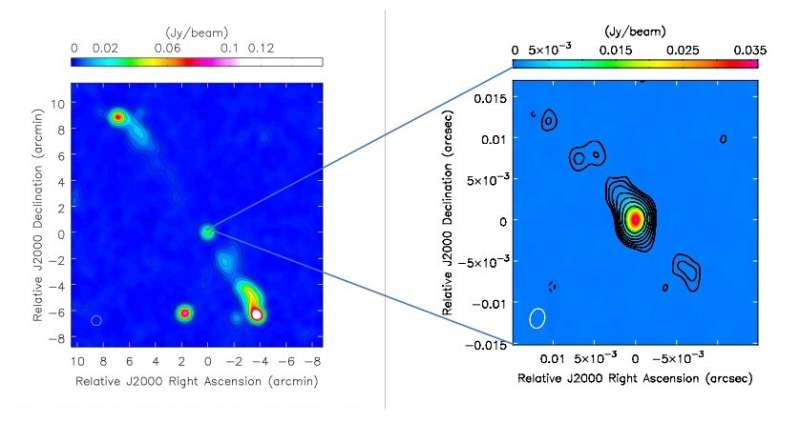August 26, 2019 report
Mrk 1498 hosts a young and obscured AGN, study finds

An international team of astronomers has found that the giant radio galaxy (GRG) Mrk 1498 has a more complex nuclear structure than previously thought. By analyzing multi-wavelength observations of Mrk 1498, a young and obscured active galactic nucleus (AGN) has been identified in the center of this galaxy. The study is detailed in a paper published August 16 on arXiv.org.
GRGs are radio galaxies with an overall projected linear length on megaparsec scales. They are rare objects grown in low-density environments. GRGs are important for astronomers to study the formation and the evolution of radio sources.
An AGN is a compact region at the center of a galaxy, more luminous than the surrounding galaxy light. Such regions are very energetic due either to the presence of a black hole, or to star formation activity at the core of the galaxy.
At a redshift of approximately 0.055, Mrk 1498 (also known WN 1626+5153 or Swift J1628.1+5145) is a GRG with emission line regions extending outward up to a distance of about 23,000 light years. Its nucleus is at the center of two giant radio lobes with a projected linear size of around 3.6 million light years.
Previous observations of Mrk 1498 have suggested that the galaxy could be photo-ionized by an AGN that has faded away or is still active but heavily absorbed. In order to verify these two scenarios, a team of astronomers led by Lorena Hernandez-Garcia of the University of Valparaíso, in Chile, more closely observed the available observational data regarding the nucleus of Mrk 1498. The dataset includes observations at radio, mid-infrared, optical and X-ray frequencies.
"In this work, we have used multiwavelength data at radio, mid-infrared, optical, ultraviolet and X-ray frequencies to study the innermost parts of the galaxy Mrk 1498," the astronomers wrote in the paper.
According to the study, the results suggest that Mrk 1498 has a heavily absorbed nucleus, which has recently restarted its nuclear activity. In particular, the research found that Mrk 1498 has a complex nuclear structure with a young radio source surrounded by a strong X-ray nuclear absorption. The observations show that the galaxy's mid-infrared spectrum is dominated by the torus emission. Moreover, a circum-nuclear extended emission was detected, assumed to be most likely due to star formation or outflowing material.
"The radio spectrum of its core is fitted by a log-parabola model with a peak at 4.9 GHz, indicative of a young radio phase, implying the reactivation of the nuclear activity. (…) Data at mid-infrared frequencies shows the typical shape of an AGN dominated by the torus emission. (…) It shows extended emission in the [OIII] emission line, which does not seem to be related to photo-ionization from the AGN, but could be either explained by star formation or outflowing material," the researchers explained.
Therefore, the results allowed the researchers to exclude the possibility that Mrk 1498 hosts a fading AGN. They believe the data clearly shows that this galaxy has an obscured but active AGN in its center. This suggests that Mrk 1498 could be a result of a merging event or secular processes, such as a minor interaction, which could be responsible for the reactivation of nuclear activity.
More information: A young and obscured AGN embedded in the giant radio galaxy Mrk 1498, arXiv:1908.06080 [astro-ph.GA] arxiv.org/abs/1908.06080
L Hernández-García et al. A young and obscured AGN embedded in the giant radio galaxy Mrk 1498, Monthly Notices of the Royal Astronomical Society (2019). DOI: 10.1093/mnras/stz2265
Journal information: Monthly Notices of the Royal Astronomical Society
Provided by Science X Network
© 2019 Science X Network




















